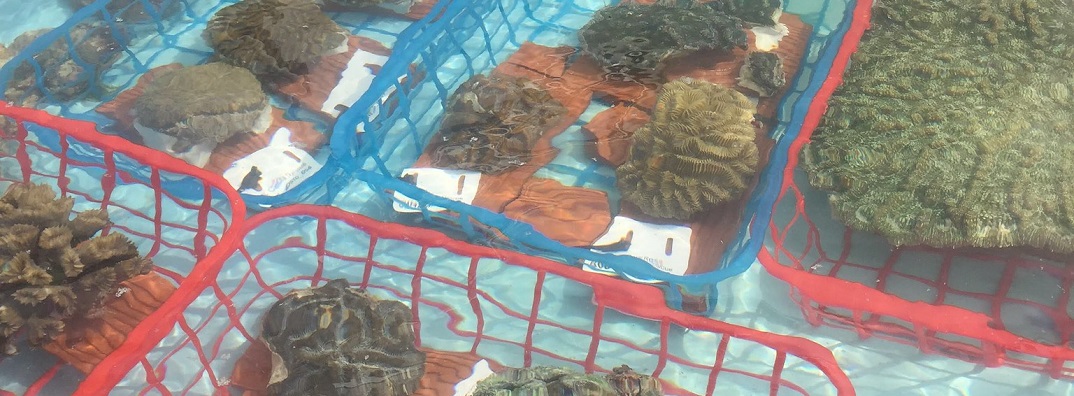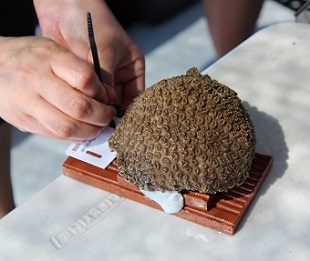- ABOUT US
- PROGRAM AREAS
- CONSERVATION APPROACH
- EDUCATION
- MULTIMEDIA
- Nearly $1 Million in NOAA Funding Recommended for Ruth Gates Coral Restoration Innovation Grants Projects
- Coral Reef Health Captured in the Atlantic, Caribbean, and Gulf of Mexico
- Aquariums and Zoos: Caring for Corals from A to Z
- Alii Belau: Hello Palau
- NOAA Responds to Ongoing Outbreak of Coral Disease in Florida
- Sharing the Nationwide Task of Coral Reef Conservation
A NOAA Strategy for Responding to Stony Coral Tissue Loss Disease

NOAA has released a strategy for the response to Stony Coral Tissue Loss Disease, a disease that is spreading throughout the Atlantic and Caribbean region and poses a threat to the Indo-Pacific region.
The high-level strategy provides a framework and focus for efforts to slow the continued spread of the disease across the Atlantic and Caribbean regions, and to prevent and prepare for the spread of the disease into the Indo-Pacific region in support of resilient coastal ecosystems, communities, and economies nationwide. The strategy will inform a national-level implementation plan.
“By prioritizing the response to stony coral tissue loss disease, NOAA will further strengthen America’s Blue Economy,” said retired Navy Rear Adm. Tim Gallaudet, Ph.D., assistant secretary of commerce for oceans and atmosphere and deputy NOAA administrator. “The disease is unlike any witnessed before, but NOAA is leading the charge to protect these resources and the communities that depend on them.”

Stony Coral Tissue Loss Disease was first observed in south Florida in 2014. As of September 2020, it has spread to 13 Caribbean countries and territories. The outbreak is unique due to its large geographic range, extended duration, rapid progression, high rates of mortality and the number of coral species affected. Once infected, coral colonies typically die within weeks to months. While the cause of the disease is still unknown, it is believed that the pathogen may have some bacterial component due to its response to antibiotic treatments. Stony Coral Tissue Loss Disease can be transmitted to other corals through direct contact and water circulation. Recently, leadership from Indo-Pacific countries and territories shared concerns that the disease could spread into the region.
NOAA is working with state and federal partners in Florida, the U.S. Virgin Islands, and Puerto Rico to lead disease response efforts in these coral reef jurisdictions, and is specifically supporting coordination with the wider Caribbean region.
View the NOAA Stony Coral Tissue Loss Disease Strategy and executive summary.
Related Stories and Products
About Us

The NOAA Coral Reef Conservation Program was established in 2000 by the Coral Reef Conservation Act. Headquartered in Silver Spring, Maryland, the program is part of NOAA's Office for Coastal Management.

The Coral Reef Information System (CoRIS) is the program's information portal that provides access to NOAA coral reef data and products.
Work With US
U.S. Coral Reef Task Force
Funding Opportunities
Employment
Fellowship Program
Contracting Assistance
Graphic Identifier
Featured Stories Archive

Access the archive of featured stories here...
Feedback
Thank you for visiting NOAA’s Coral Reef Conservation Program online. Please take our website satisfaction survey. We welcome your ideas, comments, and feedback. Questions? Email coralreef@noaa.gov.
Stay Connected
Contact Us
NOAA’s Coral Reef Conservation Program
SSMC4, 10th Floor
1305 East West Highway
Silver Spring, MD 20910
coralreef@noaa.gov
